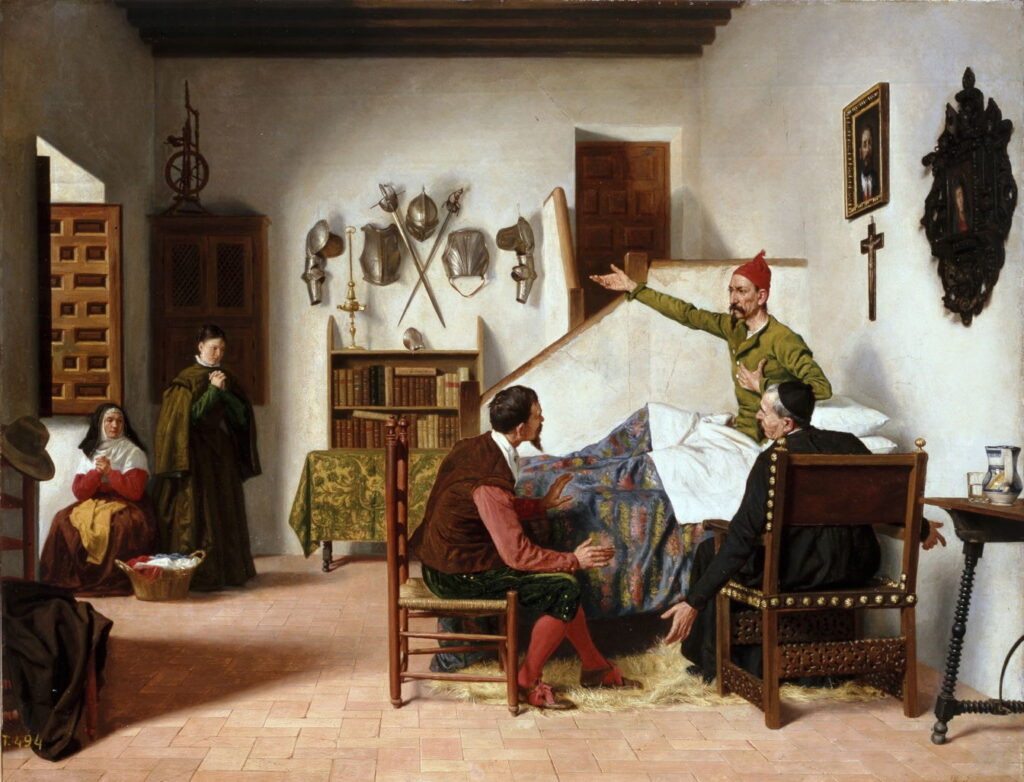Painting Don Quixote: Decline and fall

The first twenty or so chapters of Miguel de Cervantes’ groundbreaking modern novel Don Quixote consist of a series of largely self-contained comic misadventures. After the knight and his long-suffering squire Sancho Panza release a group of convicts, they fear for their safety, so head for the mountains. Once there, events become more interrelated and complex, presenting even greater challenges to those who tried to paint them in standalone works, rather than illustrations accompanying the text.
The pair find a hoard of gold coins apparently abandoned with a notebook in a travel bag. Then Don Quixote catches a glimpse of a man leaping around the bushes half-naked, and suspects that he’s the owner of the bag and its coins. A little way around the hillside, they find a dead mule whose owner they think had carried that bag.
This scene must have fascinated the French artist Honoré Daumier, who painted a series of oil sketches of it in about 1867.
Honoré Daumier (1808–1879), Don Quixote and the Dead Mule (after 1864), oil on panel, 24.8 x 46 cm, Metropolitan Museum of Art, New York, NY. Wikimedia Commons.
In the first, the knight leads his squire towards the dead mule.
Honoré Daumier (1808–1879), Don Quixote and the Dead Mule (1867), oil on canvas, 132.5 × 54.5 cm, Musée d’Orsay, Paris. Photograph by Rama, Wikimedia Commons, Cc-by-sa-2.0-fr.
This rough oil sketch shows them drawing even closer.
Honoré Daumier (1808–1879), Sancho Panza and Don Quixote in the Sierra (1866/68), oil on canvas, 29.5 x 45 cm, Private collection. Wikimedia Commons.
Sancho Panza and Don Quixote in the Sierra is more generic, and omits the dead mule altogether.
A little later, Sancho Panza’s donkey is stolen, so the knight dispatches him on his own horse Rocinante to obtain three replacement donkeys, and deliver a letter to the Lady Dulcinea, Quixote’s semi-imaginary ‘lady’ of his chivalric quests. Meanwhile, the knight laments and feigns madness for the lady. Panza meets their village priest and barber, and they agree to deceive Quixote in a bid to persuade him to return to the village for his madness to be treated.
As the three head back towards Don Quixote, they meet Dorotea, who had previously been tricked and seduced. She agrees to dress up as a fine lady and pose as Princess Micomicona, who purports to have come all the way from Guinea to ask a boon of the knight.
Pedro González Bolívar (dates not known), The Introduction of Dorotea to Don Quixote (1881), oil on canvas, 100 x 88 cm, Museo Nacional del Prado, Madrid, Spain. Wikimedia Commons.
Pedro González Bolívar’s painting of The Introduction of Dorotea to Don Quixote from 1881 shows their meeting. Without that background information, this would prove impossible to read.
Don Quixote is persuaded to leave the mountains and return home with them, but that’s the start of another series of misadventures. During these, Dorotea’s true identity is revealed, and at dinner Don Quixote gives a long and impassioned speech in which he argues surprisingly rationally in favour of the pre-eminence of arms over learning.
Manuel García Hispaleto (1836–1898), Don Quixote’s Speech of Arms and Letters (1884), oil on canvas, 152 x 197 cm, Palacio del Senado de España, Madrid, Spain. Wikimedia Commons.
This is recorded in Manuel García Hispaleto’s painting of Don Quixote’s Speech of Arms and Letters from 1884. Sancho Panza stands immediately behind the knight, at the head of the table, on the right. Seated along the table’s length are a man who has just arrived from Algiers with a Moorish woman, the village priest, and others.
Don Quixote’s madness only continues, and eventually he has to be bundled into an oxcart and taken home.
Hippolyte Lecomte (1781–1857), Don Quixote’s Homecoming (date not known), oil on canvas, 27.5 x 38.5 cm, location not known. Wikimedia Commons.
On a Sunday when all the locals are out in the square, the oxcart bearing Don Quixote enters his village at noon, as shown in Hippolyte Lecomte’s undated Don Quixote’s Homecoming. At the left, Don Quixote’s niece or housekeeper holds her hands up in horror at his condition. To the left of the cart are the priest and barber, still mounted. Sancho Panza is riding his donkey, and has been greeted by his wife and their children, who are more interested in how many fine skirts he brought back for her, and how many pairs of shoes for their children.
Miguel Jadraque y Sánchez (1840–1919), Visit of the Priest and Barber to Don Quixote (1880), oil on canvas, 53 x 64.5 cm, Museo Nacional del Prado, Madrid, Spain. Wikimedia Commons.
The priest and barber leave Don Quixote alone to recover for a month after their return, then reassess him, as shown by Miguel Jadraque in this Visit of the Priest and Barber to Don Quixote from 1880. Don Quixote is becoming animated with them as he sits up in bed. In the left background are the knight’s niece and housekeeper, praying in vain for his recovery.
Don Quixote and Sancho Panza then leave on their third sally, which first takes them on a futile mission to El Toboso in quest of the Lady Dulcinea. After that, they head towards the city of Saragossa, and meet a cart full of players in costume, who create mayhem.
Carlos Vásquez Úbeda (1869-1944), Don Quixote (date not known), oil on canvas, 160 x 278 cm, Musée Goya, Castres, France. Image by Tylwyth Eldar, via Wikimedia Commons.
Carlos Vásquez Úbeda shows this encounter in his undated painting of Don Quixote. At this stage, the pair are still on their mounts, but shortly afterwards a clown causes Rocinante to bolt and throw Don Quixote, and one of the other players rides off on the squire’s donkey. For once, Sancho manages to persuade his master not to retaliate, and they continue on their way without coming to grief.
Later, they meet a group from a village, and are invited to attend a wedding there the following day.
Manuel García Hispaleto (1836–1898), The Marriage of Basilio and Quiteria (1881), oil on canvas, 152 x 196 cm, Museo Nacional del Prado, Madrid, Spain. Courtesy of and © Museo Nacional del Prado.
The wedding brings an elaborate deception in which the bride’s first suitor appears to impale himself on his own sword so that he can marry the bride as his dying wish, but then miraculously comes back to life, to cheat the groom from marrying the bride as had been expected. Manuel García Hispaleto’s painting of The Marriage of Basilio and Quiteria from 1881 shows the priest officiating in the centre, as the bride to the right is married to the dying suitor, who is supported by Don Quixote with his lance. The groom stands at the front of the tent at the right, staring in disbelief at what’s going on.
Gustave Doré (1832–1883), Don Quixote and Sancho Panza Entertained by Basil and Quiteria (c 1863), oil on canvas, 92.1 x 73 cm, Metropolitan Museum of Art, New York, NY. Wikimedia Commons.
The newlyweds entertain Don Quixote and Sancho Panza for three days, enabling them to visit the Cave of Montesinos and the Lakes of Ruidera nearby. Gustave Doré, whose illustrations for the whole book have been used by others as the basis for further illustrated editions, painted this non-narrative scene of Don Quixote and Sancho Panza Entertained by Basil and Quiteria in about 1863.
In the middle of Cervantes’ second book of Don Quixote, the knight and his squire Sancho Panza become guests of a Duke and Duchess who had already read Cervantes’ first book, and set out to trick the pair into further comical misadventures. Soon after their arrival, the Duke’s chaplain asserts that Don Quixote isn’t a knight errant at all, causing the knight to deliver a searing riposte.
Columbano Bordalo Pinheiro (1857–1929), Don Quijote in the Duke’s House (1878), media not known, 87.4 x 133.1 cm, Pena Palace, Sintra, Portugal. Wikimedia Commons.
Out of the blue, maids arrive to wash and lather the knight’s beard, and that of the Duke, in a procedure that defuses a tense situation by transforming it into the absurd. Columbano Bordalo Pinheiro’s painting of Don Quijote in the Duke’s House from 1878 shows this bizarre moment, with the rotund figure of Sancho Panza at the left, the gaunt Don Quixote in the centre, and the Duke and Duchess seated at the right, in obvious amusement.
Although Cervantes had completed Don Quixote in 1615, and it quickly became popular across Europe, it appears to have been painted infrequently before the nineteenth century. Only Valero Iriarte seems to have painted its comical adventure stories in the previous century. Although Eugène Delacroix painted the non-narrative Don Quixote in his Library in 1824, Cervantes’ novel was generally ignored by the major narrative artists of the nineteenth century, who continued depicting mostly classical myth.
These paintings demonstrate how modern fiction can form the basis for successful narrative painting, even though that has remained unusual.




